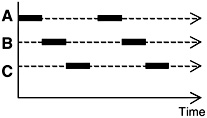Chapter 3: Concurrent Execution
Overview
The execution of a concurrent program consists of multiple processes active at the same time. As discussed in the last chapter, each process is the execution of a sequential program. A process progresses by submitting a sequence of instructions to a processor for execution. If the computer has multiple processors then instructions from a number of processes, equal to the number of physical processors, can be executed at the same time. This is sometimes referred to as parallel or real concurrent execution. However, it is usual to have more active processes than processors. In this case, the available processors are switched between processes. Figure 3.1 depicts this switching for the case of a single processor supporting three processes, A, B and C. The solid lines represent instructions from a process being executed on the processor. With a single processor, each process makes progress but, as depicted in Figure 3.1, instructions from only one process at a time can be executed.

Figure 3.1: Process switching.
The switching between processes occurs voluntarily or in response to interrupts. Interrupts signal external events such as the completion of an I/O operation or a clock tick to the processor. As can be seen from Figure 3.1, processor switching does not affect the order of instructions executed by each process. The processor executes a sequence of instructions which is an interleaving of the instruction sequences from each individual process. This form of concurrent execution using interleaving is sometimes referred to as pseudo-concurrent execution since instructions from different processes are not executed at the same time but are interleaved. We use the terms parallel and concurrent interchangeably and usually do not distinguish between real and pseudo-concurrent execution since, in general, the same programming principles and techniques are applicable to both physically (real) concurrent and interleaved execution. In fact, we always model concurrent execution as interleaved whether or not implementations run on multiple processors.
This chapter describes how programs consisting of multiple processes are modeled and illustrates the correspondence between models and implementations of concurrent programs by a multi-threaded Java example.
EAN: 2147483647
Pages: 162